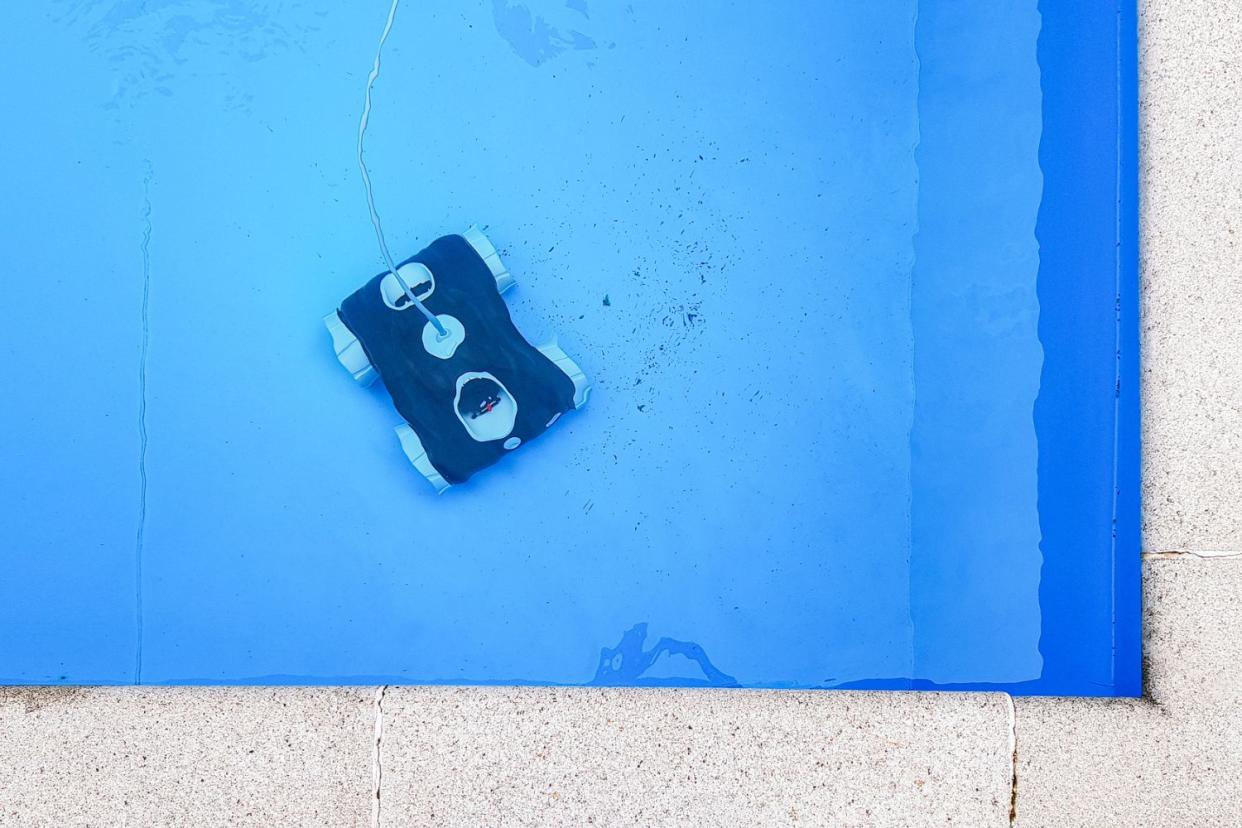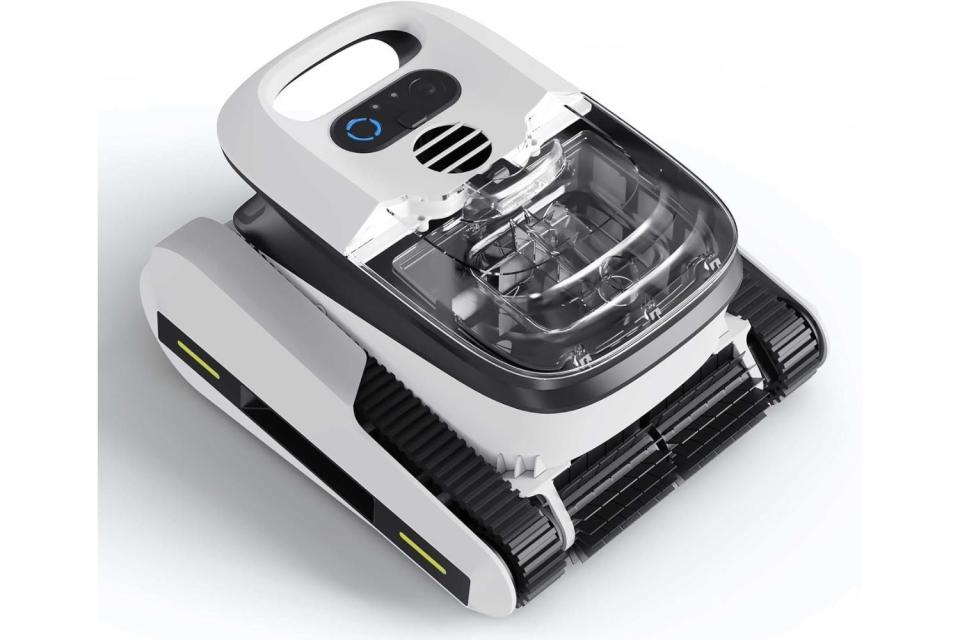The Best Cheap Robotic Pool Cleaners of 2023

Keeping a full-size pool free of debris and grime can be a lot of work, which is why robotic pool cleaners have grown so much in popularity in recent years. These automated machines incorporate built-in motors, wheels, and cleaning brushes that allow them to scour pool floors and walls while scrubbing or sucking up algae or debris along the way. Because of their high-tech designs, most robotic pool cleaners require a sizable investment—but that doesn’t mean there aren’t plenty of options that will satisfy pool owners with more limited budgets.
Like more expensive models, cheap robotic pool cleaners come in various shapes and designs. Some robotic pool cleaners feature wall-climbing capabilities necessary for traversing large inground pools, while others boast compact designs more suitable for small above-ground pools. There are also robotic pool vacuums designed to suck up leaves as well as robotic skimmers that clear debris from the pool surface. Below are some of the best cheap robotic pool cleaners on the market today.
How We Chose the Best Cheap Robotic Pool Cleaners
Because this is a review of “cheap” robotic pool cleaners, we started our research by considering what this means for the average consumer. Robotic pool cleaners can vary widely in price, from basic $100 designs to cutting-edge models over $1,000. An affordable option for most pool owners, then, might fall on the lower end of that range—below $500.
With that in mind, we rounded up as many sub-$500 robotic pool cleaners as we could find on the market today. We looked at dozens of options from a variety of brands, from leading manufacturers like Dolphin and Seauto to lesser-known names like Wybot and Ofuzzi. Reading other expert reviews allowed us to gain a sense of the reputation and reliability of these brands and models, while examining user reviews gave us important insights into how these pool cleaners performed in the real world. We also considered some of the main features that users might desire in a pool vacuum, including power mode (battery or electric cord), size, design, filter quality, and ease of use.
If price is no concern, check out our review of the best robotic pool cleaners in general.
BEST OVERALL: Seauto Seal SE Robotic Pool Cleaner

Photo: amazon.com
The Seauto robotic pool cleaner is one of the most advanced models on the market, making it an ideal choice for pool owners looking for quality features at a discount. Using sonar and other smart features, the vacuum can navigate pools with a slope gradient of less than 90 degrees and a size under 2,150 square feet. The battery can last 2.5 hours on a single charge and is easy to replace, while the self-righting function keeps the cleaner moving even when it encounters obstacles.
The Seauto does have some limitations. It’s not designed to clean waterlines, climb steps, or suck up heavy debris, such as trash or large leaves. Additionally, this cleaner is not suitable for especially large pools with extreme slopes. However, it does work on a variety of pool surfaces, from PVC to stone, and features an app that allows users to keep its operation current with seamless firmware upgrades.
Product Specs
Design: Cordless battery-powered
Best for: Inground and above-ground pools
Dimensions: 16.8 inches long by 15.6 inches wide by 11.3 inches high
Pros
Works in a variety of pool sizes and surfaces, from above-ground PVC to inground stone
Long battery life reduces the need for frequent recharging during cleaning cycles
Self-righting function helps to navigate around obstacles and continue cleaning without interruption
App allows for convenient firmware upgrades and updates
Cons
Struggles with large debris like leaves and can't clean waterlines
Not suitable for larger pools that exceed 2,150 square feet
App doesn't support underwater connection or operation
Get the Seauto cheap robotic pool cleaner at Amazon.
More Cheap Robotic Pool Cleaners Worth Your Money
For pool owners for whom the Seauto model doesn’t meet their needs or budget, plenty of other affordable robotic pool cleaners are available from a variety of brands like Dolphin, Aiper, Inse, and more.
Aiper Seagull SE Cordless Robotic Pool Cleaner, available at Amazon or Walmart.
Wybot Osprey 300 Cordless Robotic Pool Cleaner, available at Amazon.
Inse Y10 Cordless Pool Vacuum Robot, available at Amazon.
Dolphin E10 Robotic Pool Cleaner, available at Amazon or The Home Depot.
Ofuzzi Cyber Cordless Robotic Pool Cleaner, available at Amazon or Walmart.
Paxcess Cordless Robotic Pool Cleaner, available at Amazon or Walmart.
What to Consider When Choosing a Cheap Robotic Pool Cleaner
Just because a robotic pool cleaner is cheap doesn’t mean it can’t offer similar performance and value as more expensive options. However, it’s important for pool owners to carefully consider the features of each model and their own particular needs before making an investment. The performance and effectiveness of a pool cleaner can depend on several factors, including the size and type of the pool and the design and weight of the vacuum itself. In this section, we'll explore these key considerations to help shoppers find the perfect cheap robot pool cleaner to suit their needs.
Pool Type
One of the most important factors when shopping for automatic pool cleaners is the type of swimming pool. For example, above-ground pools often have flat bottoms, while inground pools are typically of various shapes and depths. Robotic pool cleaners themselves also have their limits—some models are only designed to handle pools of a certain square footage, while others may be limited in their ability to climb pool walls and inclines. A robotic cleaner designed for an inground pool may not perform optimally in an above-ground pool, and vice versa.
Additionally, the construction material of the pool—whether vinyl, fiberglass, or concrete—can affect how well a pool cleaner operates. Some robotic vacuums may work effectively on PVC and tile linings but struggle on stone or concrete. Using a cleaner not designed for a certain pool type may result in inefficient cleaning, potential damage to the cleaner or the pool, and ultimately, extra expenses. In general, it’s important to check the manufacturer’s specifications to determine if a particular robotic pool cleaner is suitable for a certain type of pool.
Pool Size
Another crucial consideration when shopping for a cheap robotic cleaner is the size of the pool. As previously noted, robotic pool cleaners may vary in runtime and capacity, and some are specifically designed to handle pools of a certain size. If a pool is larger than the cleaner's capacity or runtime, it may not complete the cleaning cycle in one cycle, leaving parts of the pool untouched. This is especially a problem with battery-powered cleaners, which tend to offer shorter cycle times than those that connect to electric cords.
Conversely, if a pool is smaller, a cleaner with a larger capacity or longer runtime may be unnecessary, potentially causing a buyer to overspend. Matching the model’s capabilities to the pool’s size ensures efficient and cost-effective cleaning.
Filter Canister
When considering the overall design of a robotic pool cleaner, it’s important to examine the size and quality of the filter canister, or filtration basket. This is especially true for budget models since they often have a smaller canister that can fill up quickly in pools that are large or contain a lot of debris. Opting for a model with a larger filter canister can save time and hassle by reducing the frequency of emptying and cleaning it during automatic cleaning cycles.
The kind of filter canister can also determine how easy it is to maintain the pool cleaner. Many cheaper robotic pool cleaners feature top-loading filter canisters that are straightforward to access and clean. This convenience simplifies the upkeep of the cleaner, helping pool owners get the most out of their investment over the long run.
Weight
One final factor to consider when shopping for an affordable robotic pool cleaner is weight. A lightweight cleaner is generally easier to handle and maneuver, making it more user-friendly during setup and retrieval. This is especially important for budget-conscious buyers who may not want to lift large equipment or struggle with heavy machinery. A lighter cleaner is also less likely to cause damage to delicate pool surfaces, such as vinyl liners.
Additionally, the weight of the cleaner can affect its ability to climb pool walls and steps within the pool. Lighter models may have limitations in this regard, struggling to maintain suction and grip on vertical surfaces. When selecting an inexpensive robotic pool cleaner, it's essential to match the weight of the cleaner with the type of pool.
FAQs
Robotic pool cleaners can help take the work out of pool cleaning by automating the process, but using them effectively is not as simple as plopping them in the water and letting them run. Below, we address some common questions that pool owners might encounter when operating their first robotic pool cleaner.
Q. Do I really need pool automation?
Pool automation is not necessary, but it can take a lot of the manual labor out of pool maintenance and help keep a pool cleaner than owners would otherwise be able to do themselves.
Q. How long does a pool robot take to clean a pool?
Cleaning time varies based both on the pool's size and the robot's capacity, but a typical estimate is between 1 and 3 hours.
Q. Do pool robots use a lot of electricity?
In general, most pool robots are energy-efficient, but the amount of electricity they use depends on their size and design.
Q. Do pool robots work in cold water?
Yes, pool robots can operate in cold water, but some models may have limitations in extremely low temperatures.
Q. How long should I run my pool cleaner every day?
Running a pool cleaner for 1 to 3 hours per day is usually sufficient to maintain a clean pool, but it may depend on factors like the size of the pool or how much debris is in the pool.
Why Trust Bob Vila
Bob Vila has been America’s Handyman since 1979. As the host of beloved and groundbreaking TV series including “This Old House” and “Bob Vila’s Home Again,” he popularized and became synonymous with “do-it-yourself” home improvement.
Over the course of his decades-long career, Bob Vila has helped millions of people build, renovate, repair, and live better each day—a tradition that continues today with expert yet accessible home advice. The Bob Vila team distills need-to-know information into project tutorials, maintenance guides, tool 101s, and more. These home and garden experts then thoroughly research, vet, and recommend products that support homeowners, renters, DIYers, and professionals in their to-do lists.

